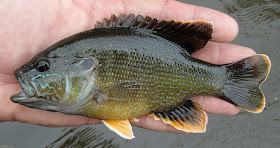 |
| Green Sunfish adult. Photo by Nate Tessler. Source. |
 |
| Juvenile Green Sunfish. Photo by Dan Johnson. Source |
Green Sunfish is
tolerant of a wide range of environmental conditions. Therefore, it is often
found in sloughs and ditches where no other sunfish is present. It is usually one of the few sunfish that will
persist in small streams of the Great Plains along with Creek Chubs Semotilus atromaculatus, Fathead Minnows
Pimephales promelas, and Black
Bullheads Ameirus melas. Because of their broad geographic
distribution and wide environmental tolerance, the index of biotic integrity in
the Midwest USA has a Green Sunfish metric (Metric 6, Proportion of
individuals as green
sunfish). That always seemed speciesist, and the meaning of metric 6 should
reflect proportion of highly tolerant fish.
Some streams are naturally harsh and the Green Sunfish is able to
persist in harsh environments. That
should not influence the assessment of biological impairment. Harsh places are not necessarily impaired. However, Green Sunfish have become widespread
outside its native range where they may suppress native fishes (Fuller et al.
2016).
 |
| Distribution of Green Sunfish (Fuller et al. 2016) USGS |
The Green
Sunfish seldom get large enough to attract the following of recreational anglers. However, it is usually so common, especially
in intermittent creeks, that it is a good fish for young anglers to
target. Green Sunfish provided me many
an evening meal while camping during my dissertation research studies on Glover
River, Oklahoma. Here the Green Sunfish
was the dominant fish species, comprising 46% of total biomass (Orth and
Maughan 1984). Green Sunfish are also
popular as an aquarium fish for the native fish enthusiast because they feed
readily and may persist under less than ideal water quality conditions.
Sunfishes are
notorious for hybridizing in nature.
Many species overlap in range, spawning time, and share limited nesting
habitats. More than 20 Lepomis hybrids have been reported in
nature (Childers 1967). Natural hybrids are produced when one species at very
low abundance and females of rarer Lepomis
breed with an aggressive male of the dominant species (Avise and Saunders 1984).
These F1 hybrid exhibit adult sex ratios strongly biased toward males
and, consequently, hybrid sunfish have been bred specifically for pond
stocking. The Green Sunfish x Bluegill
cross is popular. Click here for photo of the F1 hybrid and parentals.
Video of Green Sunfish gill flare display. by CarpGuy Source
The spot on the
soft dorsal fin also darkens when the Green Sunfish is interacting with
another. Greenberg observed that the
fighting individual “almost always has these spots intensified, but, if it
loses the fight, the spots disappear.” Although many others have described
aggressive behavior and territorial defense and displays, the experiments of
Bernard Greenberg established that the Green Sunfish engaged in aggressive
behavior and defend territories long before they became reproductively mature.
Greenberg also
observed changes in the coloration of the eye during agonistic encounters. The iris is normally red. Hence the Green Sunfish is sometimes referred
to as a goggle eye. However, when Green Sunfish are fighting the
red becomes more prominent. In a Green
Sunfish that loses in an encounter the black pigment spreads to the rest of the
iris and the red is obscured.
Consequently the black eye signals a sign of defeat in the Green
Sunfish.
 |
| Close up of head of Green Sunfish. photo by BluegillFishing.net. Source. |
The fighting pattern
of two Green Sunfish involves one individual on the attack with gills flared
and the other weaving to avoid being nipped. The attacker may make a series of vigorous
nips at the head or body and may even lock jaws. In aquaria, groups of Green Sunfish establish a pattern of
dominance within 24 hours. Individuals learn to display subordinate patterns. Further
maze experiments by Greenberg supported the notion that dominant individuals in
groups facilitated learning among members. In an experiment comparing Green Sunfish in
isolation and in groups, the individuals in groups grew faster over the period
of study (Allee et al. 1948). Reasons
for enhanced growth are difficult to establish, although the authors did
observe fish in social groups displaying more ready feeding. Also, the high ranking fish within a social
hierarchy ate more and grew faster than low ranking ones.
The Green
Sunfish is an excellent example of a common opportunistic sunfish species that
has a rich set of social interactions that have not yet been fully
explored. What you may see as aggressive
interactions in aquaria are adaptations that will facilitate group success and
resource distribution in wild populations.
Also, Green Sunfish have double cones in their eyes that make them
sensitive to polarized light (Cameron and Easter 1993). The adaptive significance of polarized light
sensitivity has yet to be explored. We
can only speculate and devise new experiments.
References
Allee, W.C., B. Greenberg, G.M.
Rosenthal, and P. Frank. 1948. Some effects of social organization on growth
in the Green Sunfish Lepomis cyanellus. Journal
of Experimental Biology 108:1-19.
Avise, J. C., and N.C. Saunders. 1984.
Hybridization and introgression among species of sunfish (Lepomis): Analysis by mitochondrial DNA and allozyme markers. Genetics 108:237-255.
Cameron, D.A., and S.S.Easter.1993. The
cone photoreceptor mosaic of the green sunfish, Lepomis cyanellus. Visual
Neuroscience 10:375-384.
Childers, W.F. 1967. Hybridization of
four species of sunfishes (Centrarchidae).
Bulletin of the Illinois Natural
History Survey 29:159-214.
Fuller, P., M. Cannister, and M. Neilson.
2016. Lepomis cyanellus. USGS Nonindigenous Aquatic Species Database,
Gainesville, FL.
http://nas.er.usgs.gov/queries/FactSheet.aspx?speciesID=380 Revision Date: 1/20/2012
http://nas.er.usgs.gov/queries/FactSheet.aspx?speciesID=380 Revision Date: 1/20/2012
Greenberg, B. 1947. Some relations between territory,
social hierarchy, and leadership in the Green Sunfish (Lepomis cyanellus). Physiological Zoology 20:267-299.
Orth, D.J., and O.E. Maughan. 1984. Community structure and seasonal changes in
standing stocks of fish in a warm-water stream. American Midland Naturalist 112:369-378.


